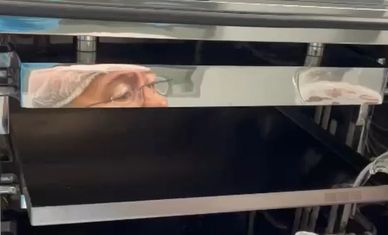Our experience
Active Product Ingredient (API) lyophilization in bulk, optimizing the production. East Europe.

This customer from east of Europe was looking for enhancing the production of its Active Pharmaceutical Ingredient (API) and the lyophilization step was the bottleneck.
In what is known as Primary Pharmaceutical Processing, the method for preserving, storing and transporting the APIs is typically lyophilization, due its multiple advantages.
Differently to final product lyophilization in the Secondary Pharmaceutical Processing (where the final drug is produced), in API production in bulk, the product filling height for lyophilization is not restricted by the final dose to the patient, and it can be optimized for enhancing the production.
But adding the filling height as an additional variable to the optimization process (additionally to the freeze dryer pressure and temperature of the shelves), increased notably the complexity, requiring generating multiple lyophilization desing spaces, for different filling heights, what was only possible by complementing experimental tests with simulation.
The quantity of product loaded in a freeze dryer is directly proportional to the filling height, but unfortunately the lyophilization time increases exponentially to it (due the pressure gradient at the dried cake).
After this really interesting project, we can state that as a rule of thumb, the optimum cycle time occurs when is close to the time between batches.
Nevertheless, after the firsts optimization cycle runs, the freeze drying process happened not longer to be the bottleneck, and our customer decided to perform only one high production batch per week, that even not being the optimum in terms of lyophilization, it was it in terms of production, saving efforts and time for the operations between batches.
Toxic product. Single use tray with protective membrane. Central Europe.

For extracting a crucial bacteria in a pharmeceutical process, this customer at center Europe required a drying step with lyophilization. The process was performed in bulk and when the product was dried it entailed a hazard to the operators.
When a product is freeze dried becomes very volatile and the toxicity risk for the operators is increased. This is the reason why precautions as containment like isolators or other sterile barriers should be considered.
Additionally, even the proces of this customer did not require to be sterile, the biological burden needed to be controlled.
At this point the equipment that was being considered at the User Requirement Specifications, was a freeze dryer including sterilization by steam, and Cleaning in Place, connected to a fixed isolator. For the filling it was considered a table top unit compatible with hydrogen peroxide decontamination inside the solator.
Lyoptimus Thermodynamics was asked for advise, as the cost of the equipment was surpasing the budget allocated to it. The batch size required was small, freeze dryer with less than 2m2 of usable surface area.
As per the small size of the production, the first advise from Lyoptimus was to make use of Ready To Use (RTU), Single Use (SU), trays with high performance protective membrane, for not allowing the inlet of contaminants, neither the flyout of product.
The project was simplified as it was not longer needed the fixed isolator for the freeze dryer loading/unloading, neither steam sterilization, nor Cleaning In Place at the freeze dryer.
For the filling of the trays Lyoptimus Thermodynamics proposed a lab isolator including a fluid port. Then a conventional table top peristaltic pump could be used outside the isolator.
From manual to automatic loading. Rebuilding the freeze drying recipe. South America.
From manual to automatic loading. Rebuilding the freeze drying recipe. South America.

In South America, one of the biggest local pharmaceutical manufacturers, wanted to be addapted to the new GMP Annex 1. They were consireing to fully replace a production line with four freeze dryers and a filling line. The lyophilizers vial loading needed to change from manual with trays to automatic.
Our customer was evaluating a brand new line with row by row loading for each freeze dryer connected to a new filling line.
From Lyoptimus we were asked to update the freeze drying recipe, because as the vials were going to be in direct contact with the freeze drying shelves, it was expected to have better heat transfer and improve the production.
From Lyoptimus, we fast explained that no improvement in production can be expected for the direct contact of the vials, due the same heat load should be provided to the product to do not exceed the critical temperature. Nevertheless, we were able to efficiently adapt the freeze drying recipe for it by modelization, as the heat transfer coeficient (Kv) of vials and trays can be acuretaly parametrized.
Additionally, we were interested about the existent freeze dryers, what happened to be from a reputed manufacturer, with good and robust operation. It was a fortunetless situation that they could not upgraded due specially the unloading of the vials from the shelves required major modifications.
Them from Lyoptimus Thermodynamics, we proposed the option of working with frames, by upgrading the filling machine with a row by row loader of frames (single for all the lyophilizers), and only including a pusher/puller of frames at the front of the freeze dryers.
Our proposition was welcomed and we supported the customer in the definition and supply of the upgrade. Insted of replacing the old units, it was possible to increase the production with the new line preserving the old.
Contact Us
From Barcelona
We are based in Barcelona and we operate internationally
